Sainsbury's: Adapting Marketing in International Markets
VerifiedAdded on 2023/06/13
|10
|2573
|493
Report
AI Summary
This report analyzes Sainsbury's international marketing strategies, focusing on the differences between local and international markets, the rationale for international expansion, and various market entry routes such as licensing, exporting, and franchising. It evaluates the key criteria for selecting international markets, including opportunities and challenges, and examines different market entry strategies with their advantages and disadvantages. The report also critically assesses how Sainsbury's should adapt its marketing strategies for diverse international markets, recommending franchising and licensing as effective strategies for cost-effective expansion and increased market reach. The conclusion emphasizes the importance of international marketing for profitability and recommends that Sainsbury's leverage franchising to engage a larger customer base.
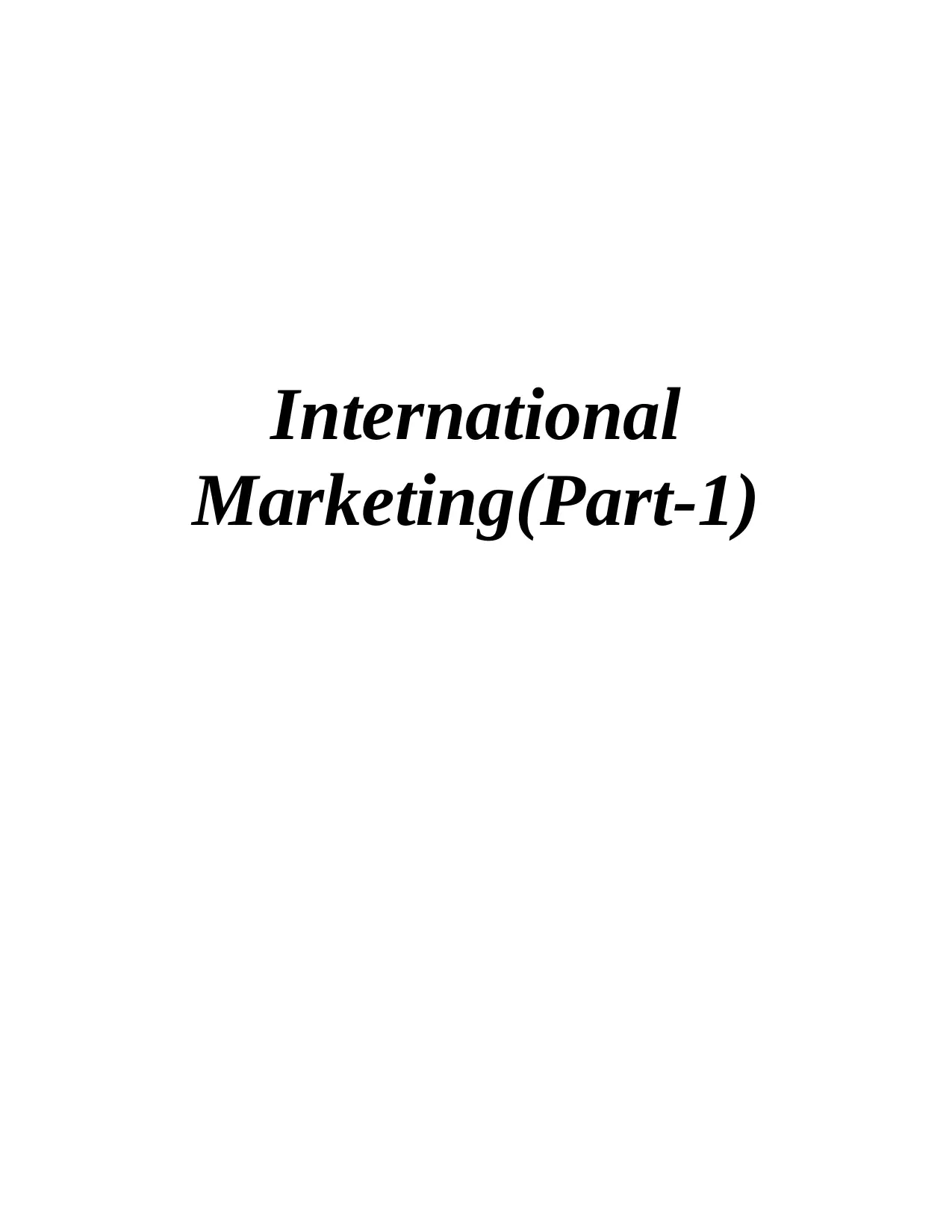
International
Marketing(Part-1)
Marketing(Part-1)
Paraphrase This Document
Need a fresh take? Get an instant paraphrase of this document with our AI Paraphraser
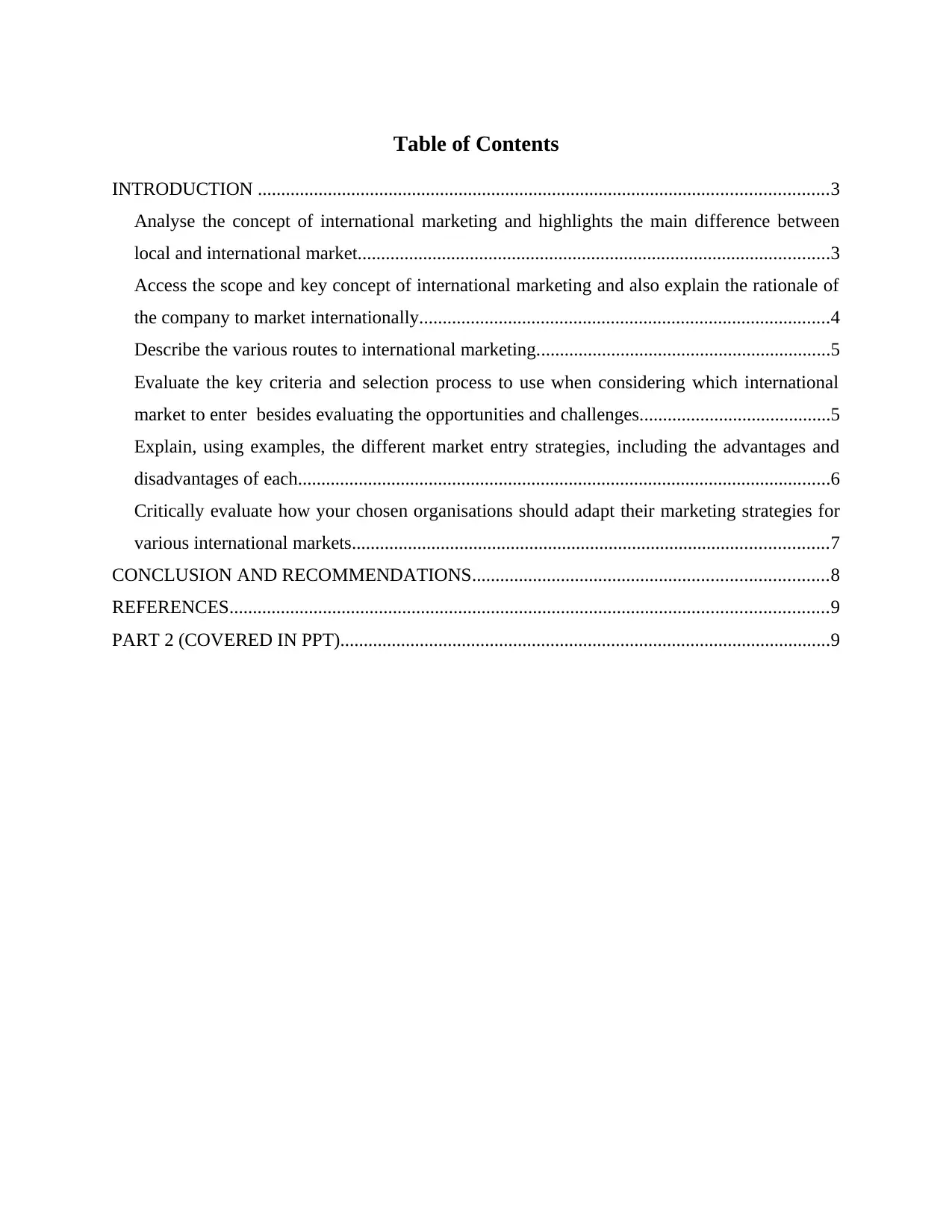
Table of Contents
INTRODUCTION ..........................................................................................................................3
Analyse the concept of international marketing and highlights the main difference between
local and international market.....................................................................................................3
Access the scope and key concept of international marketing and also explain the rationale of
the company to market internationally........................................................................................4
Describe the various routes to international marketing...............................................................5
Evaluate the key criteria and selection process to use when considering which international
market to enter besides evaluating the opportunities and challenges.........................................5
Explain, using examples, the different market entry strategies, including the advantages and
disadvantages of each..................................................................................................................6
Critically evaluate how your chosen organisations should adapt their marketing strategies for
various international markets......................................................................................................7
CONCLUSION AND RECOMMENDATIONS............................................................................8
REFERENCES................................................................................................................................9
PART 2 (COVERED IN PPT).........................................................................................................9
INTRODUCTION ..........................................................................................................................3
Analyse the concept of international marketing and highlights the main difference between
local and international market.....................................................................................................3
Access the scope and key concept of international marketing and also explain the rationale of
the company to market internationally........................................................................................4
Describe the various routes to international marketing...............................................................5
Evaluate the key criteria and selection process to use when considering which international
market to enter besides evaluating the opportunities and challenges.........................................5
Explain, using examples, the different market entry strategies, including the advantages and
disadvantages of each..................................................................................................................6
Critically evaluate how your chosen organisations should adapt their marketing strategies for
various international markets......................................................................................................7
CONCLUSION AND RECOMMENDATIONS............................................................................8
REFERENCES................................................................................................................................9
PART 2 (COVERED IN PPT).........................................................................................................9
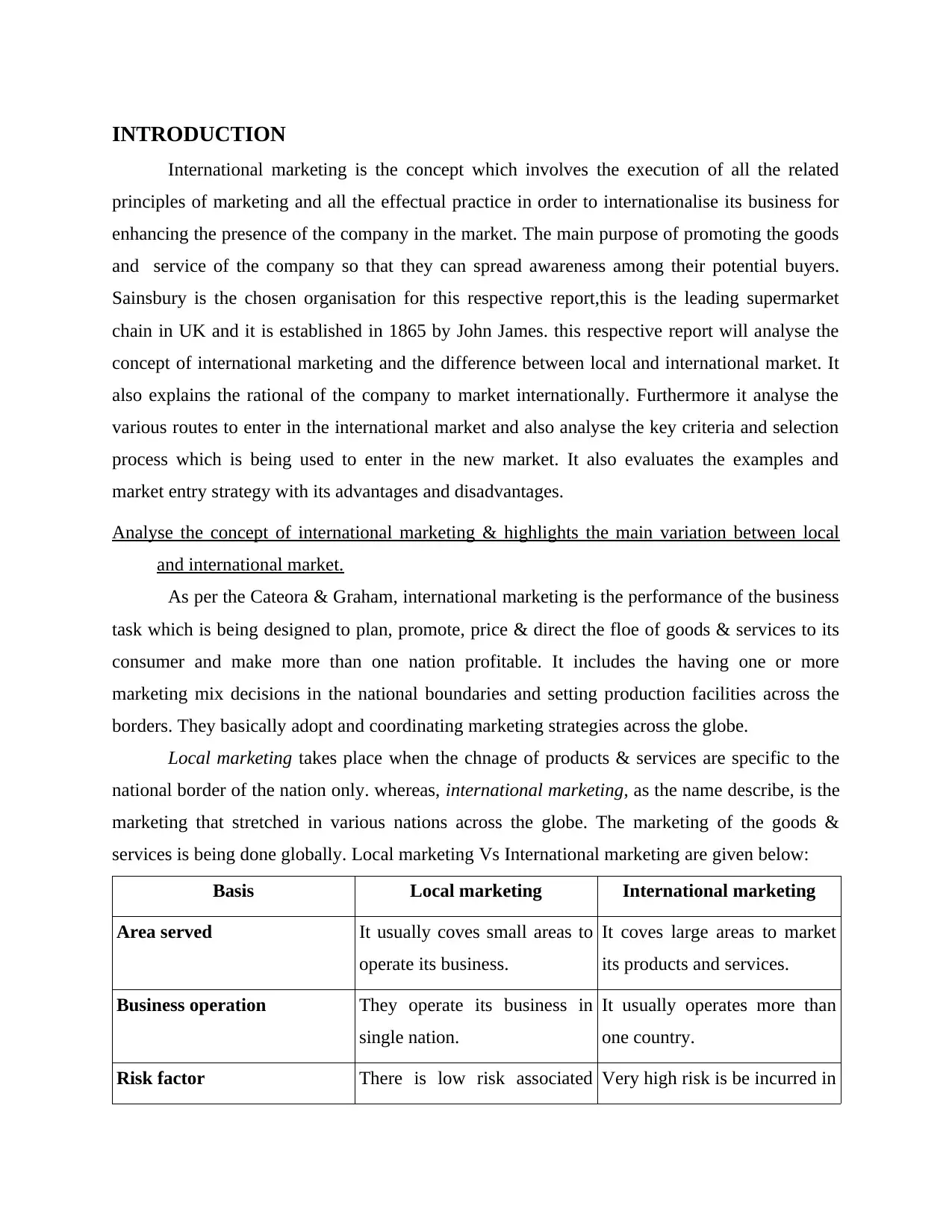
INTRODUCTION
International marketing is the concept which involves the execution of all the related
principles of marketing and all the effectual practice in order to internationalise its business for
enhancing the presence of the company in the market. The main purpose of promoting the goods
and service of the company so that they can spread awareness among their potential buyers.
Sainsbury is the chosen organisation for this respective report,this is the leading supermarket
chain in UK and it is established in 1865 by John James. this respective report will analyse the
concept of international marketing and the difference between local and international market. It
also explains the rational of the company to market internationally. Furthermore it analyse the
various routes to enter in the international market and also analyse the key criteria and selection
process which is being used to enter in the new market. It also evaluates the examples and
market entry strategy with its advantages and disadvantages.
Analyse the concept of international marketing & highlights the main variation between local
and international market.
As per the Cateora & Graham, international marketing is the performance of the business
task which is being designed to plan, promote, price & direct the floe of goods & services to its
consumer and make more than one nation profitable. It includes the having one or more
marketing mix decisions in the national boundaries and setting production facilities across the
borders. They basically adopt and coordinating marketing strategies across the globe.
Local marketing takes place when the chnage of products & services are specific to the
national border of the nation only. whereas, international marketing, as the name describe, is the
marketing that stretched in various nations across the globe. The marketing of the goods &
services is being done globally. Local marketing Vs International marketing are given below:
Basis Local marketing International marketing
Area served It usually coves small areas to
operate its business.
It coves large areas to market
its products and services.
Business operation They operate its business in
single nation.
It usually operates more than
one country.
Risk factor There is low risk associated Very high risk is be incurred in
International marketing is the concept which involves the execution of all the related
principles of marketing and all the effectual practice in order to internationalise its business for
enhancing the presence of the company in the market. The main purpose of promoting the goods
and service of the company so that they can spread awareness among their potential buyers.
Sainsbury is the chosen organisation for this respective report,this is the leading supermarket
chain in UK and it is established in 1865 by John James. this respective report will analyse the
concept of international marketing and the difference between local and international market. It
also explains the rational of the company to market internationally. Furthermore it analyse the
various routes to enter in the international market and also analyse the key criteria and selection
process which is being used to enter in the new market. It also evaluates the examples and
market entry strategy with its advantages and disadvantages.
Analyse the concept of international marketing & highlights the main variation between local
and international market.
As per the Cateora & Graham, international marketing is the performance of the business
task which is being designed to plan, promote, price & direct the floe of goods & services to its
consumer and make more than one nation profitable. It includes the having one or more
marketing mix decisions in the national boundaries and setting production facilities across the
borders. They basically adopt and coordinating marketing strategies across the globe.
Local marketing takes place when the chnage of products & services are specific to the
national border of the nation only. whereas, international marketing, as the name describe, is the
marketing that stretched in various nations across the globe. The marketing of the goods &
services is being done globally. Local marketing Vs International marketing are given below:
Basis Local marketing International marketing
Area served It usually coves small areas to
operate its business.
It coves large areas to market
its products and services.
Business operation They operate its business in
single nation.
It usually operates more than
one country.
Risk factor There is low risk associated Very high risk is be incurred in
⊘ This is a preview!⊘
Do you want full access?
Subscribe today to unlock all pages.

Trusted by 1+ million students worldwide
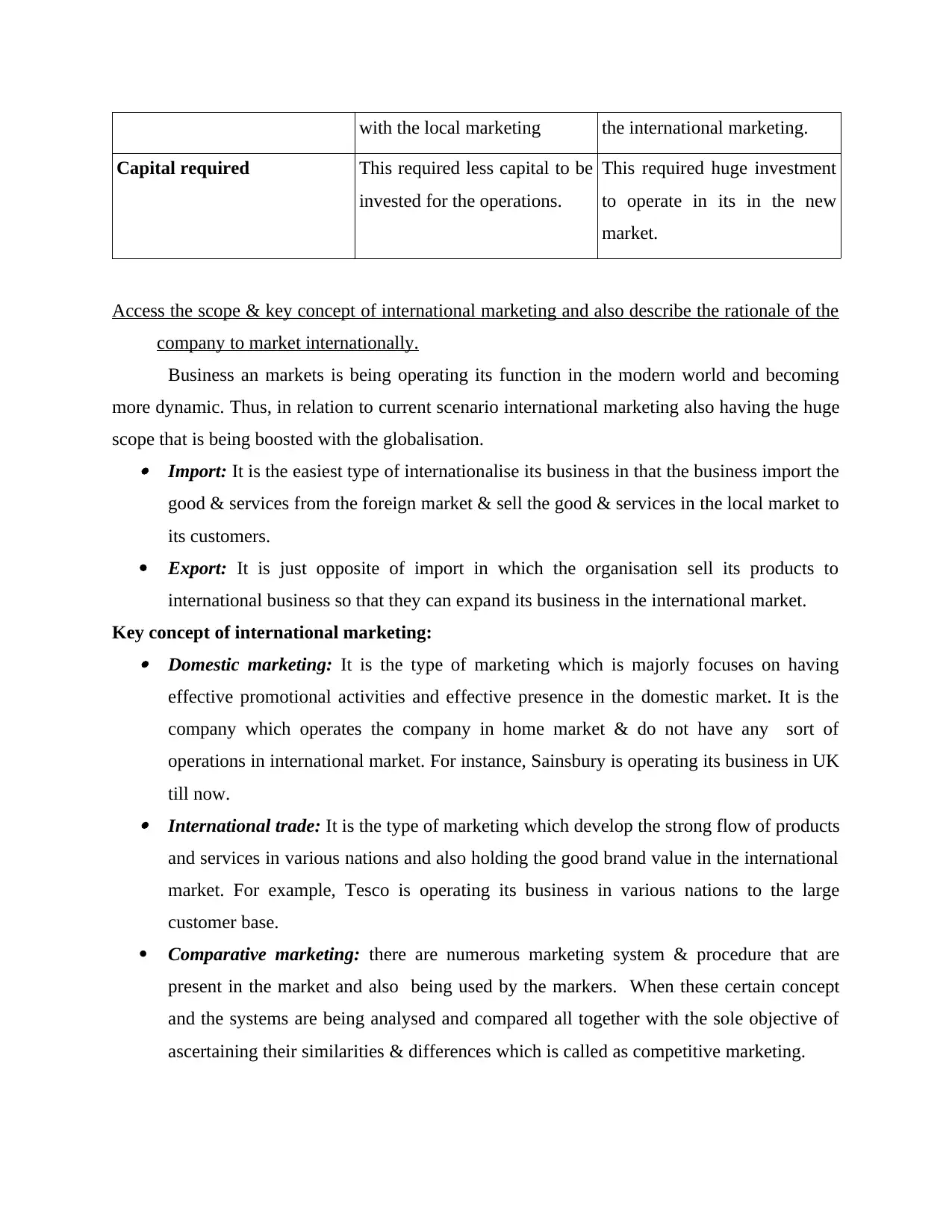
with the local marketing the international marketing.
Capital required This required less capital to be
invested for the operations.
This required huge investment
to operate in its in the new
market.
Access the scope & key concept of international marketing and also describe the rationale of the
company to market internationally.
Business an markets is being operating its function in the modern world and becoming
more dynamic. Thus, in relation to current scenario international marketing also having the huge
scope that is being boosted with the globalisation. Import: It is the easiest type of internationalise its business in that the business import the
good & services from the foreign market & sell the good & services in the local market to
its customers.
Export: It is just opposite of import in which the organisation sell its products to
international business so that they can expand its business in the international market.
Key concept of international marketing: Domestic marketing: It is the type of marketing which is majorly focuses on having
effective promotional activities and effective presence in the domestic market. It is the
company which operates the company in home market & do not have any sort of
operations in international market. For instance, Sainsbury is operating its business in UK
till now. International trade: It is the type of marketing which develop the strong flow of products
and services in various nations and also holding the good brand value in the international
market. For example, Tesco is operating its business in various nations to the large
customer base.
Comparative marketing: there are numerous marketing system & procedure that are
present in the market and also being used by the markers. When these certain concept
and the systems are being analysed and compared all together with the sole objective of
ascertaining their similarities & differences which is called as competitive marketing.
Capital required This required less capital to be
invested for the operations.
This required huge investment
to operate in its in the new
market.
Access the scope & key concept of international marketing and also describe the rationale of the
company to market internationally.
Business an markets is being operating its function in the modern world and becoming
more dynamic. Thus, in relation to current scenario international marketing also having the huge
scope that is being boosted with the globalisation. Import: It is the easiest type of internationalise its business in that the business import the
good & services from the foreign market & sell the good & services in the local market to
its customers.
Export: It is just opposite of import in which the organisation sell its products to
international business so that they can expand its business in the international market.
Key concept of international marketing: Domestic marketing: It is the type of marketing which is majorly focuses on having
effective promotional activities and effective presence in the domestic market. It is the
company which operates the company in home market & do not have any sort of
operations in international market. For instance, Sainsbury is operating its business in UK
till now. International trade: It is the type of marketing which develop the strong flow of products
and services in various nations and also holding the good brand value in the international
market. For example, Tesco is operating its business in various nations to the large
customer base.
Comparative marketing: there are numerous marketing system & procedure that are
present in the market and also being used by the markers. When these certain concept
and the systems are being analysed and compared all together with the sole objective of
ascertaining their similarities & differences which is called as competitive marketing.
Paraphrase This Document
Need a fresh take? Get an instant paraphrase of this document with our AI Paraphraser
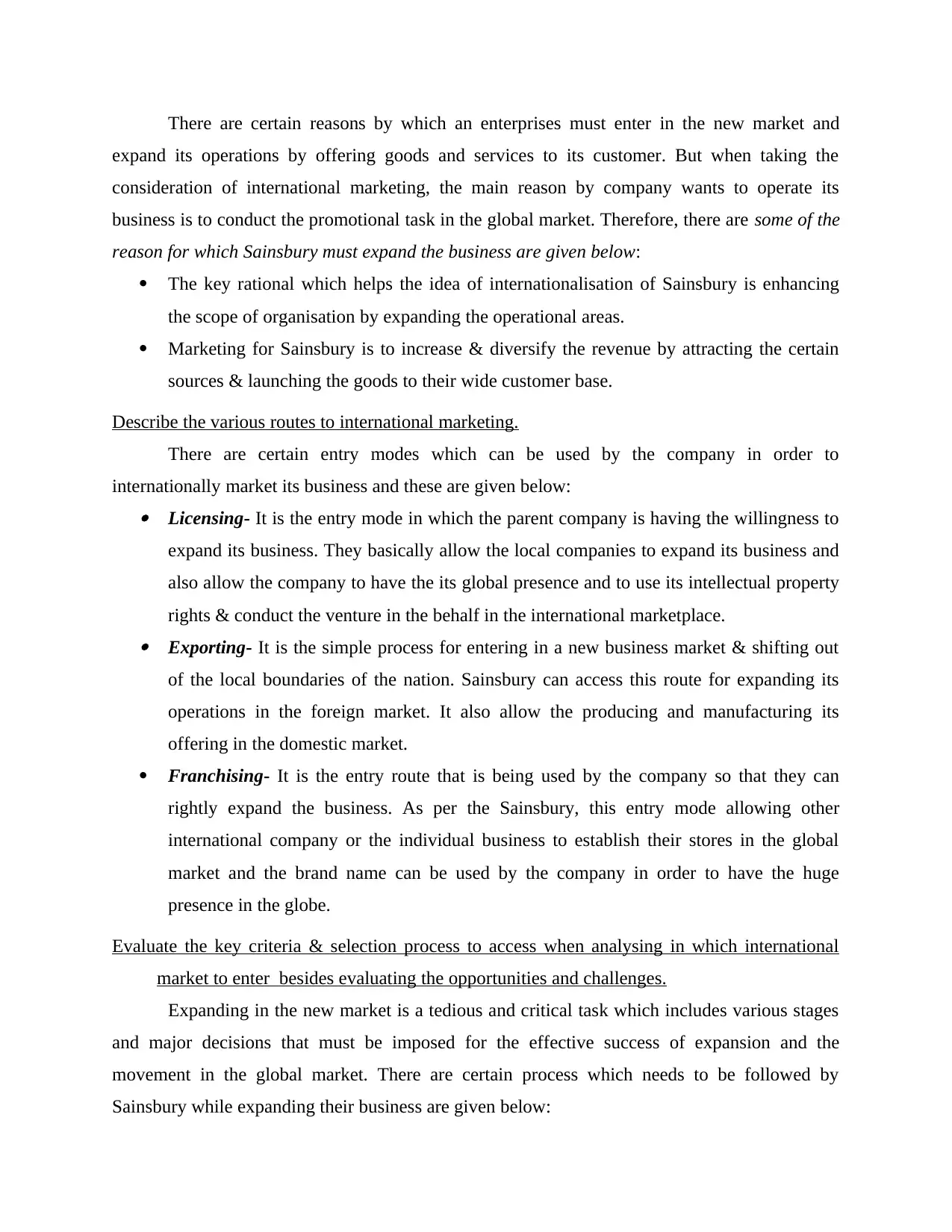
There are certain reasons by which an enterprises must enter in the new market and
expand its operations by offering goods and services to its customer. But when taking the
consideration of international marketing, the main reason by company wants to operate its
business is to conduct the promotional task in the global market. Therefore, there are some of the
reason for which Sainsbury must expand the business are given below:
The key rational which helps the idea of internationalisation of Sainsbury is enhancing
the scope of organisation by expanding the operational areas.
Marketing for Sainsbury is to increase & diversify the revenue by attracting the certain
sources & launching the goods to their wide customer base.
Describe the various routes to international marketing.
There are certain entry modes which can be used by the company in order to
internationally market its business and these are given below: Licensing- It is the entry mode in which the parent company is having the willingness to
expand its business. They basically allow the local companies to expand its business and
also allow the company to have the its global presence and to use its intellectual property
rights & conduct the venture in the behalf in the international marketplace. Exporting- It is the simple process for entering in a new business market & shifting out
of the local boundaries of the nation. Sainsbury can access this route for expanding its
operations in the foreign market. It also allow the producing and manufacturing its
offering in the domestic market.
Franchising- It is the entry route that is being used by the company so that they can
rightly expand the business. As per the Sainsbury, this entry mode allowing other
international company or the individual business to establish their stores in the global
market and the brand name can be used by the company in order to have the huge
presence in the globe.
Evaluate the key criteria & selection process to access when analysing in which international
market to enter besides evaluating the opportunities and challenges.
Expanding in the new market is a tedious and critical task which includes various stages
and major decisions that must be imposed for the effective success of expansion and the
movement in the global market. There are certain process which needs to be followed by
Sainsbury while expanding their business are given below:
expand its operations by offering goods and services to its customer. But when taking the
consideration of international marketing, the main reason by company wants to operate its
business is to conduct the promotional task in the global market. Therefore, there are some of the
reason for which Sainsbury must expand the business are given below:
The key rational which helps the idea of internationalisation of Sainsbury is enhancing
the scope of organisation by expanding the operational areas.
Marketing for Sainsbury is to increase & diversify the revenue by attracting the certain
sources & launching the goods to their wide customer base.
Describe the various routes to international marketing.
There are certain entry modes which can be used by the company in order to
internationally market its business and these are given below: Licensing- It is the entry mode in which the parent company is having the willingness to
expand its business. They basically allow the local companies to expand its business and
also allow the company to have the its global presence and to use its intellectual property
rights & conduct the venture in the behalf in the international marketplace. Exporting- It is the simple process for entering in a new business market & shifting out
of the local boundaries of the nation. Sainsbury can access this route for expanding its
operations in the foreign market. It also allow the producing and manufacturing its
offering in the domestic market.
Franchising- It is the entry route that is being used by the company so that they can
rightly expand the business. As per the Sainsbury, this entry mode allowing other
international company or the individual business to establish their stores in the global
market and the brand name can be used by the company in order to have the huge
presence in the globe.
Evaluate the key criteria & selection process to access when analysing in which international
market to enter besides evaluating the opportunities and challenges.
Expanding in the new market is a tedious and critical task which includes various stages
and major decisions that must be imposed for the effective success of expansion and the
movement in the global market. There are certain process which needs to be followed by
Sainsbury while expanding their business are given below:
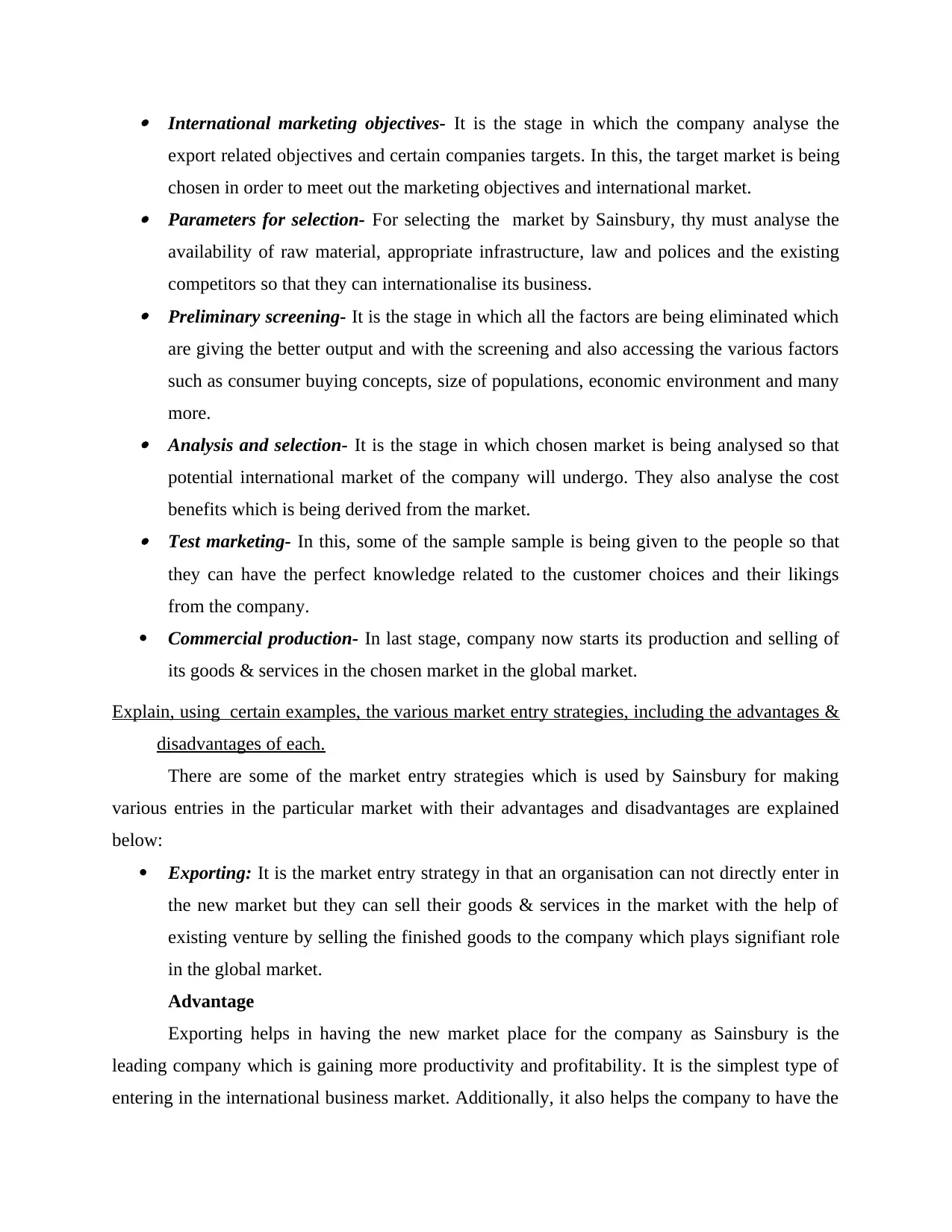
International marketing objectives- It is the stage in which the company analyse the
export related objectives and certain companies targets. In this, the target market is being
chosen in order to meet out the marketing objectives and international market. Parameters for selection- For selecting the market by Sainsbury, thy must analyse the
availability of raw material, appropriate infrastructure, law and polices and the existing
competitors so that they can internationalise its business. Preliminary screening- It is the stage in which all the factors are being eliminated which
are giving the better output and with the screening and also accessing the various factors
such as consumer buying concepts, size of populations, economic environment and many
more. Analysis and selection- It is the stage in which chosen market is being analysed so that
potential international market of the company will undergo. They also analyse the cost
benefits which is being derived from the market. Test marketing- In this, some of the sample sample is being given to the people so that
they can have the perfect knowledge related to the customer choices and their likings
from the company.
Commercial production- In last stage, company now starts its production and selling of
its goods & services in the chosen market in the global market.
Explain, using certain examples, the various market entry strategies, including the advantages &
disadvantages of each.
There are some of the market entry strategies which is used by Sainsbury for making
various entries in the particular market with their advantages and disadvantages are explained
below:
Exporting: It is the market entry strategy in that an organisation can not directly enter in
the new market but they can sell their goods & services in the market with the help of
existing venture by selling the finished goods to the company which plays signifiant role
in the global market.
Advantage
Exporting helps in having the new market place for the company as Sainsbury is the
leading company which is gaining more productivity and profitability. It is the simplest type of
entering in the international business market. Additionally, it also helps the company to have the
export related objectives and certain companies targets. In this, the target market is being
chosen in order to meet out the marketing objectives and international market. Parameters for selection- For selecting the market by Sainsbury, thy must analyse the
availability of raw material, appropriate infrastructure, law and polices and the existing
competitors so that they can internationalise its business. Preliminary screening- It is the stage in which all the factors are being eliminated which
are giving the better output and with the screening and also accessing the various factors
such as consumer buying concepts, size of populations, economic environment and many
more. Analysis and selection- It is the stage in which chosen market is being analysed so that
potential international market of the company will undergo. They also analyse the cost
benefits which is being derived from the market. Test marketing- In this, some of the sample sample is being given to the people so that
they can have the perfect knowledge related to the customer choices and their likings
from the company.
Commercial production- In last stage, company now starts its production and selling of
its goods & services in the chosen market in the global market.
Explain, using certain examples, the various market entry strategies, including the advantages &
disadvantages of each.
There are some of the market entry strategies which is used by Sainsbury for making
various entries in the particular market with their advantages and disadvantages are explained
below:
Exporting: It is the market entry strategy in that an organisation can not directly enter in
the new market but they can sell their goods & services in the market with the help of
existing venture by selling the finished goods to the company which plays signifiant role
in the global market.
Advantage
Exporting helps in having the new market place for the company as Sainsbury is the
leading company which is gaining more productivity and profitability. It is the simplest type of
entering in the international business market. Additionally, it also helps the company to have the
⊘ This is a preview!⊘
Do you want full access?
Subscribe today to unlock all pages.

Trusted by 1+ million students worldwide
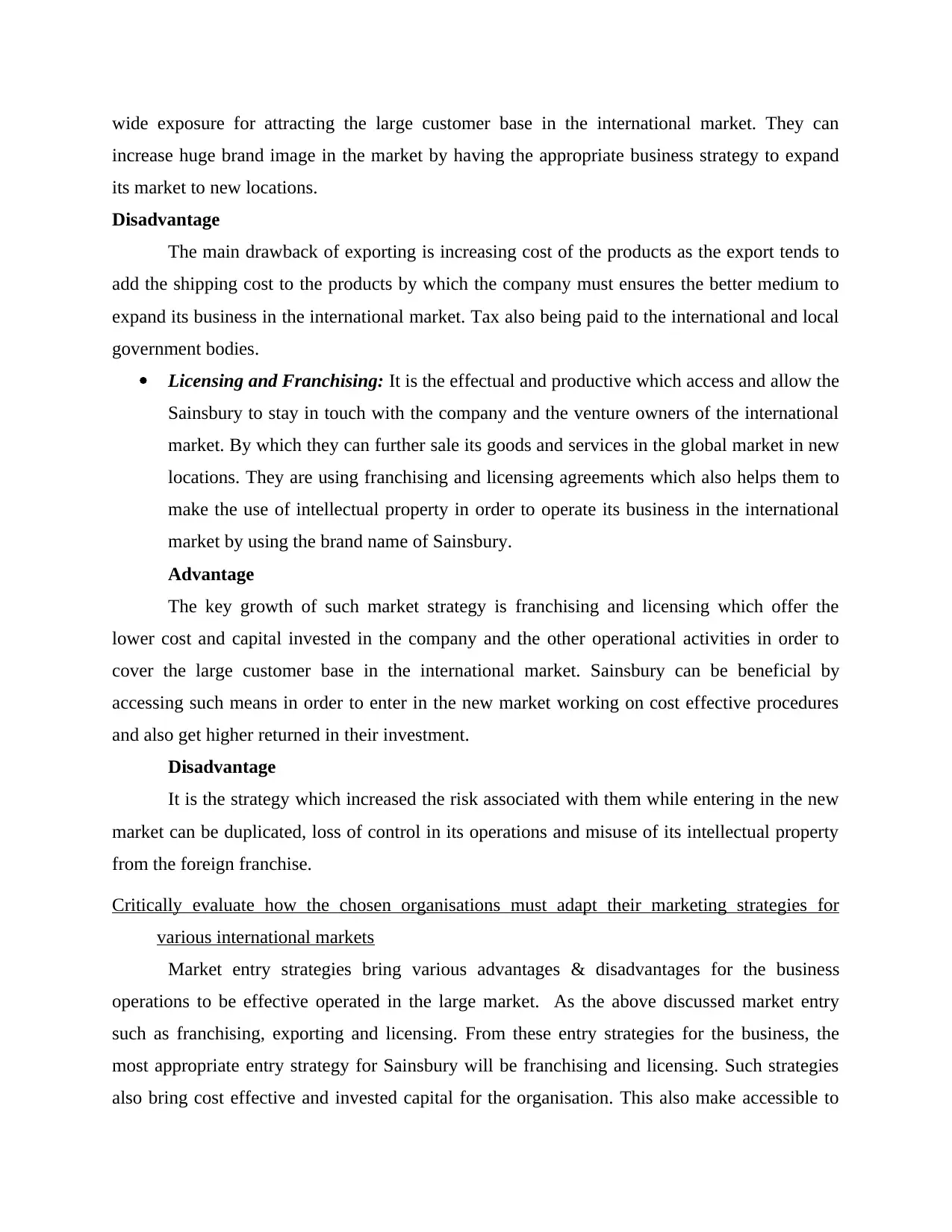
wide exposure for attracting the large customer base in the international market. They can
increase huge brand image in the market by having the appropriate business strategy to expand
its market to new locations.
Disadvantage
The main drawback of exporting is increasing cost of the products as the export tends to
add the shipping cost to the products by which the company must ensures the better medium to
expand its business in the international market. Tax also being paid to the international and local
government bodies.
Licensing and Franchising: It is the effectual and productive which access and allow the
Sainsbury to stay in touch with the company and the venture owners of the international
market. By which they can further sale its goods and services in the global market in new
locations. They are using franchising and licensing agreements which also helps them to
make the use of intellectual property in order to operate its business in the international
market by using the brand name of Sainsbury.
Advantage
The key growth of such market strategy is franchising and licensing which offer the
lower cost and capital invested in the company and the other operational activities in order to
cover the large customer base in the international market. Sainsbury can be beneficial by
accessing such means in order to enter in the new market working on cost effective procedures
and also get higher returned in their investment.
Disadvantage
It is the strategy which increased the risk associated with them while entering in the new
market can be duplicated, loss of control in its operations and misuse of its intellectual property
from the foreign franchise.
Critically evaluate how the chosen organisations must adapt their marketing strategies for
various international markets
Market entry strategies bring various advantages & disadvantages for the business
operations to be effective operated in the large market. As the above discussed market entry
such as franchising, exporting and licensing. From these entry strategies for the business, the
most appropriate entry strategy for Sainsbury will be franchising and licensing. Such strategies
also bring cost effective and invested capital for the organisation. This also make accessible to
increase huge brand image in the market by having the appropriate business strategy to expand
its market to new locations.
Disadvantage
The main drawback of exporting is increasing cost of the products as the export tends to
add the shipping cost to the products by which the company must ensures the better medium to
expand its business in the international market. Tax also being paid to the international and local
government bodies.
Licensing and Franchising: It is the effectual and productive which access and allow the
Sainsbury to stay in touch with the company and the venture owners of the international
market. By which they can further sale its goods and services in the global market in new
locations. They are using franchising and licensing agreements which also helps them to
make the use of intellectual property in order to operate its business in the international
market by using the brand name of Sainsbury.
Advantage
The key growth of such market strategy is franchising and licensing which offer the
lower cost and capital invested in the company and the other operational activities in order to
cover the large customer base in the international market. Sainsbury can be beneficial by
accessing such means in order to enter in the new market working on cost effective procedures
and also get higher returned in their investment.
Disadvantage
It is the strategy which increased the risk associated with them while entering in the new
market can be duplicated, loss of control in its operations and misuse of its intellectual property
from the foreign franchise.
Critically evaluate how the chosen organisations must adapt their marketing strategies for
various international markets
Market entry strategies bring various advantages & disadvantages for the business
operations to be effective operated in the large market. As the above discussed market entry
such as franchising, exporting and licensing. From these entry strategies for the business, the
most appropriate entry strategy for Sainsbury will be franchising and licensing. Such strategies
also bring cost effective and invested capital for the organisation. This also make accessible to
Paraphrase This Document
Need a fresh take? Get an instant paraphrase of this document with our AI Paraphraser
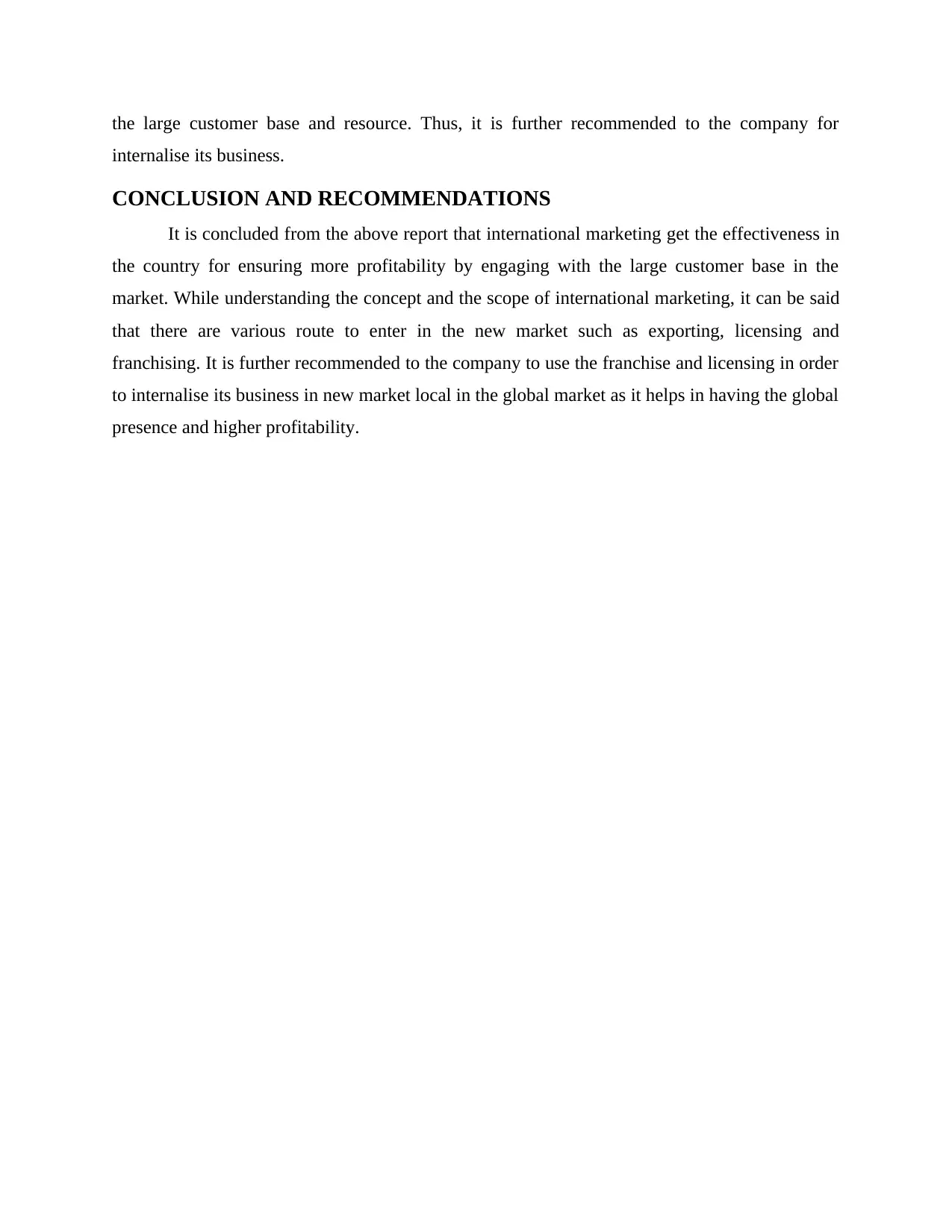
the large customer base and resource. Thus, it is further recommended to the company for
internalise its business.
CONCLUSION AND RECOMMENDATIONS
It is concluded from the above report that international marketing get the effectiveness in
the country for ensuring more profitability by engaging with the large customer base in the
market. While understanding the concept and the scope of international marketing, it can be said
that there are various route to enter in the new market such as exporting, licensing and
franchising. It is further recommended to the company to use the franchise and licensing in order
to internalise its business in new market local in the global market as it helps in having the global
presence and higher profitability.
internalise its business.
CONCLUSION AND RECOMMENDATIONS
It is concluded from the above report that international marketing get the effectiveness in
the country for ensuring more profitability by engaging with the large customer base in the
market. While understanding the concept and the scope of international marketing, it can be said
that there are various route to enter in the new market such as exporting, licensing and
franchising. It is further recommended to the company to use the franchise and licensing in order
to internalise its business in new market local in the global market as it helps in having the global
presence and higher profitability.
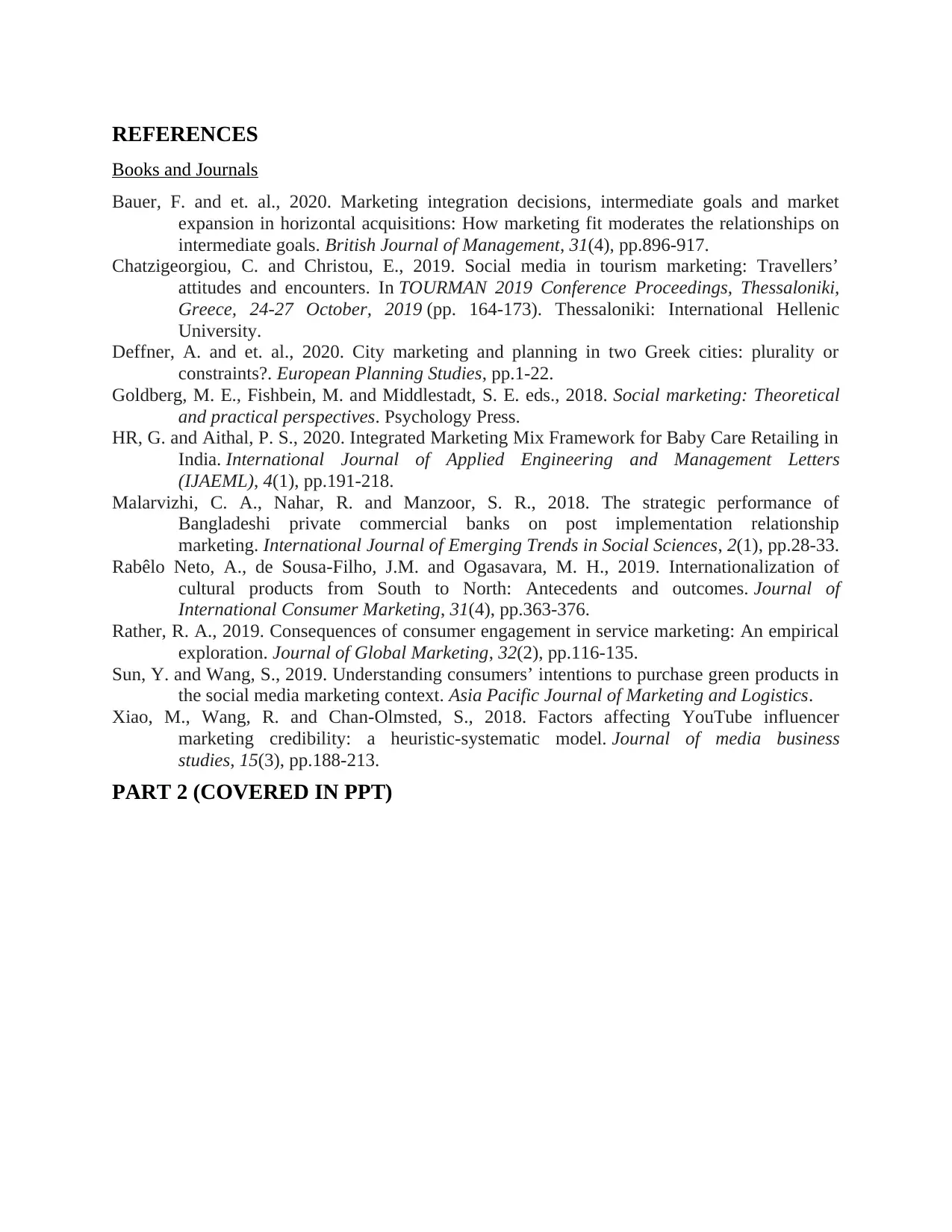
REFERENCES
Books and Journals
Bauer, F. and et. al., 2020. Marketing integration decisions, intermediate goals and market
expansion in horizontal acquisitions: How marketing fit moderates the relationships on
intermediate goals. British Journal of Management, 31(4), pp.896-917.
Chatzigeorgiou, C. and Christou, E., 2019. Social media in tourism marketing: Travellers’
attitudes and encounters. In TOURMAN 2019 Conference Proceedings, Thessaloniki,
Greece, 24-27 October, 2019 (pp. 164-173). Thessaloniki: International Hellenic
University.
Deffner, A. and et. al., 2020. City marketing and planning in two Greek cities: plurality or
constraints?. European Planning Studies, pp.1-22.
Goldberg, M. E., Fishbein, M. and Middlestadt, S. E. eds., 2018. Social marketing: Theoretical
and practical perspectives. Psychology Press.
HR, G. and Aithal, P. S., 2020. Integrated Marketing Mix Framework for Baby Care Retailing in
India. International Journal of Applied Engineering and Management Letters
(IJAEML), 4(1), pp.191-218.
Malarvizhi, C. A., Nahar, R. and Manzoor, S. R., 2018. The strategic performance of
Bangladeshi private commercial banks on post implementation relationship
marketing. International Journal of Emerging Trends in Social Sciences, 2(1), pp.28-33.
Rabêlo Neto, A., de Sousa-Filho, J.M. and Ogasavara, M. H., 2019. Internationalization of
cultural products from South to North: Antecedents and outcomes. Journal of
International Consumer Marketing, 31(4), pp.363-376.
Rather, R. A., 2019. Consequences of consumer engagement in service marketing: An empirical
exploration. Journal of Global Marketing, 32(2), pp.116-135.
Sun, Y. and Wang, S., 2019. Understanding consumers’ intentions to purchase green products in
the social media marketing context. Asia Pacific Journal of Marketing and Logistics.
Xiao, M., Wang, R. and Chan-Olmsted, S., 2018. Factors affecting YouTube influencer
marketing credibility: a heuristic-systematic model. Journal of media business
studies, 15(3), pp.188-213.
PART 2 (COVERED IN PPT)
Books and Journals
Bauer, F. and et. al., 2020. Marketing integration decisions, intermediate goals and market
expansion in horizontal acquisitions: How marketing fit moderates the relationships on
intermediate goals. British Journal of Management, 31(4), pp.896-917.
Chatzigeorgiou, C. and Christou, E., 2019. Social media in tourism marketing: Travellers’
attitudes and encounters. In TOURMAN 2019 Conference Proceedings, Thessaloniki,
Greece, 24-27 October, 2019 (pp. 164-173). Thessaloniki: International Hellenic
University.
Deffner, A. and et. al., 2020. City marketing and planning in two Greek cities: plurality or
constraints?. European Planning Studies, pp.1-22.
Goldberg, M. E., Fishbein, M. and Middlestadt, S. E. eds., 2018. Social marketing: Theoretical
and practical perspectives. Psychology Press.
HR, G. and Aithal, P. S., 2020. Integrated Marketing Mix Framework for Baby Care Retailing in
India. International Journal of Applied Engineering and Management Letters
(IJAEML), 4(1), pp.191-218.
Malarvizhi, C. A., Nahar, R. and Manzoor, S. R., 2018. The strategic performance of
Bangladeshi private commercial banks on post implementation relationship
marketing. International Journal of Emerging Trends in Social Sciences, 2(1), pp.28-33.
Rabêlo Neto, A., de Sousa-Filho, J.M. and Ogasavara, M. H., 2019. Internationalization of
cultural products from South to North: Antecedents and outcomes. Journal of
International Consumer Marketing, 31(4), pp.363-376.
Rather, R. A., 2019. Consequences of consumer engagement in service marketing: An empirical
exploration. Journal of Global Marketing, 32(2), pp.116-135.
Sun, Y. and Wang, S., 2019. Understanding consumers’ intentions to purchase green products in
the social media marketing context. Asia Pacific Journal of Marketing and Logistics.
Xiao, M., Wang, R. and Chan-Olmsted, S., 2018. Factors affecting YouTube influencer
marketing credibility: a heuristic-systematic model. Journal of media business
studies, 15(3), pp.188-213.
PART 2 (COVERED IN PPT)
⊘ This is a preview!⊘
Do you want full access?
Subscribe today to unlock all pages.

Trusted by 1+ million students worldwide

1 out of 10
Related Documents
Your All-in-One AI-Powered Toolkit for Academic Success.
+13062052269
info@desklib.com
Available 24*7 on WhatsApp / Email
![[object Object]](/_next/static/media/star-bottom.7253800d.svg)
Unlock your academic potential
Copyright © 2020–2025 A2Z Services. All Rights Reserved. Developed and managed by ZUCOL.



